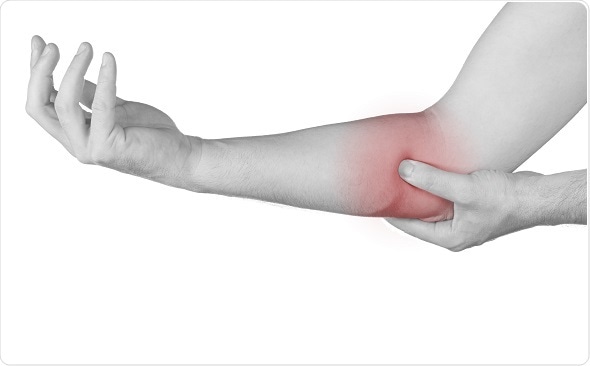Living with Elbow Pain
Many individuals who suffer from elbow pain must struggle to cope with the changes to their lifestyle that need to occur as a result of the condition. The pain management plan usually involves a combination of drugs and physical therapy, which should be adhered to by the patient in the every day living environment. This article includes advice about medical management, at-home care, and activities for patients with elbow pain.

©Melodia plus photos / Shutterstock.com
Medical management
It is usually best for patients with elbow pain to take analgesics, or pain-relieving medication, before the pain becomes more severe. The worse the pain, the harder it is to treat. For this reason, the pain management plan for most patients with severe elbow pain includes baseline analgesics to be taken on a regular basis, in addition to as-needed doses for when the pain is worse. However, patients with mild to moderate pain may not require ongoing pain relief.
Patients should also be informed about the possible side effects associated with the medications that they take so that they can recognize them if they occur. For example, non-steroidal anti-inflammatory drugs (NSAIDs) are associated with an increased risk of stomach ulcers and worsening of asthma symptoms. If patients can recognize the signs of these complications, appropriate action can be taken in a more timely manner.
At home care
There are several ways that elbow pain can be managed more effectively in the home environment. For example, a heat or ice pack can be applied to the area to ease pain or reduce inflammation.
Most patients with elbow pain should be shown and taught to do stretches and exercises of the elbow and arm which promote healing, flexibility, and strength of the connective tissues in the area. It is important that these exercises are carried out regularly to prevent the stiffening or weakening of the muscles. In most cases, the exercises should be repeated several times each day during the recovery period.
Activities
It is important for patients with elbow pain to identify certain activities or movements that may be associated with causing or worsening the pain. Patients may find it helpful to keep a pain diary to record the severity of their pain and potential triggers. The efficacy of pain-relieving medications should also be recorded, as this can help medical practitioners to make appropriate decisions about the pain management plan.
Patients with chronic elbow pain may find it difficult to go about daily tasks that involve arm movements, such as getting dressed, making the bed, or driving.
Ideally, the appropriate pain management pain should relieve the pain and allow the patient to go about their routine daily living activities. However, in most cases, there are some activities or movements that should be avoided while the area heals, as well as to prevent the recurrence of elbow pain.
An occupational therapist may be able to help by providing alternative solutions to completing daily tasks. Various devices, such as reaches, zipper aids, and brushes with an extended handle, may be useful for some individuals.
Braces or splints may also be used to reinforce and support the muscles in the arm during certain activities. For example, an epicondylitis clasp is a type of splint that can be used to reduce the strain on the elbow during activities that may worsen pain.
References
- http://www.arthritis.org/about-arthritis/where-it-hurts/elbow-pain/elbow-care/prevent-elbow-pain.php
- http://emedicine.medscape.com/article/96638-treatment
- http://www.arthritisresearchuk.org/arthritis-information/conditions/elbow-pain/what-can-i-do-to-help-myself.aspx
- http://www.arthritisresearchuk.org/arthritis-information/conditions/elbow-pain/tennis-elbow-exercises.aspx
- https://www.betterhealth.vic.gov.au/health/conditionsandtreatments/elbow-pain
Further Reading
- All Elbow Pain Content
- Causes of Elbow or Arm Pain
- Elbow Pain Management
- What is Tennis Elbow?
Last Updated: Feb 26, 2019

Written by
Yolanda Smith
Yolanda graduated with a Bachelor of Pharmacy at the University of South Australia and has experience working in both Australia and Italy. She is passionate about how medicine, diet and lifestyle affect our health and enjoys helping people understand this. In her spare time she loves to explore the world and learn about new cultures and languages.
Source: Read Full Article
